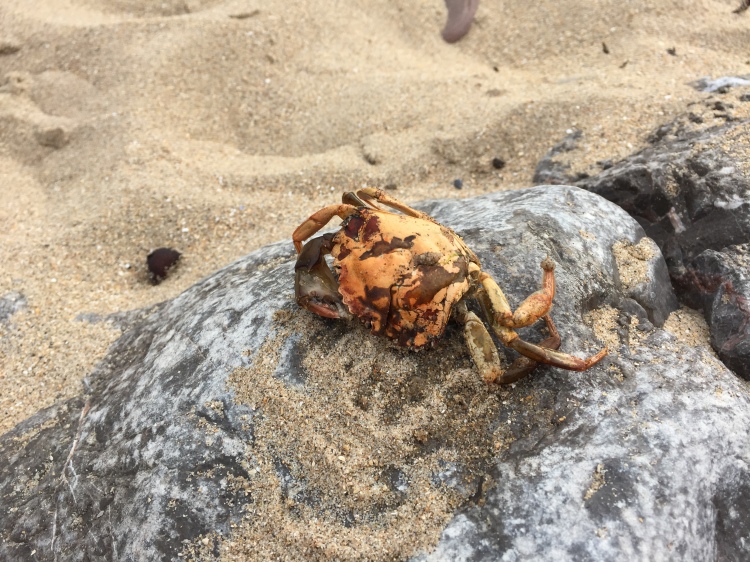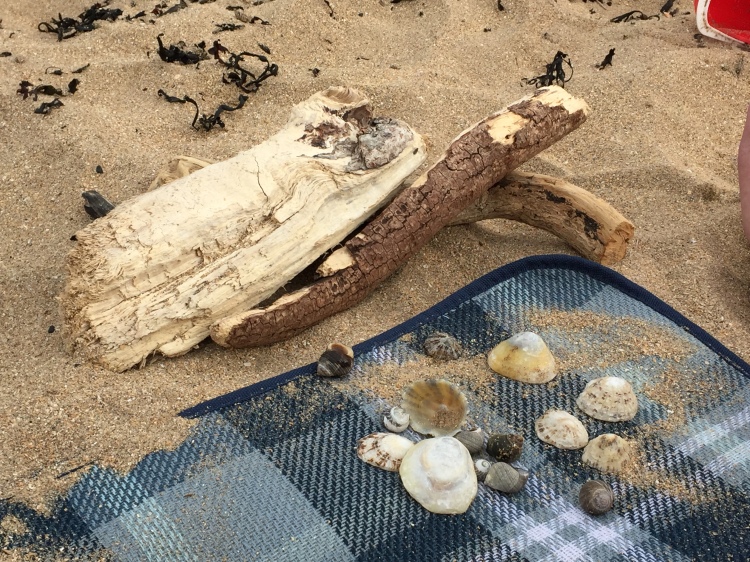The weather has been beautiful here and has prompted many beach trips of late. Not only is the beach a fun place for the kids to play, it is a great place to explore. There’s no better way for the kids to learn about nature, than experiencing nature through exploration.
We went to one of the more rocky coved beaches, which has lots of rock pools to explore and of course rocks to climb. So what did we find?

One of our first finds was what we first thought was a dead crab, but on closer inspection and a little research. We learned it was actually a crab shell which the crab had outgrown. The Crab shell is its skeleton (exoskeleton), but instead of been on the inside they wear it like armour on the outside, to protect them from predators. When they out grow them like a piece of clothing they climb out of it and hide until their new shell hardens to protect them again. In the winter in a rockpool we actually came across a live crab that had just left it’s shell, it’s body felt soft and spongy, this is when a crab is most vulnerable to predators.
Crab facts for the kids
- Crabs are Decapods and are part of the crustacean family.
- Crabs have 4 pairs of legs for walking and a pair of pincers, these are the claw like limbs at the front. Pincers are used for catching prey, fighting and communication.
- The name for a group of crabs is a cast.
- There are over 4500 species of crab.
- Crabs can live in the ocean, fresh water or on land.
- The largest species of crab is the Japanese Spider Crab, it has a leg span of up to 4 metres (13ft) Wow that’s big, I definitely wouldn’t want to come across this one while swimming.
- Most crabs walk sideways, however some species can walk forward and backwards.
Enough about crabs now, as the kids found lots of other interesting treasures on the beach. Including driftwood and shells.

This led on to some more natural learning about shells. As you can see our collection shows quite a few different types. Including Limpet and Common Winkle.
Sea shell facts
- Seashells are mostly made of calcium.
- Seashells are the external skeleton of sea creatures known as mollusc. Unlike humans and mammals where the skeleton is inside the body, mollusk have external skeletons.
- Shells protect the creatures from predators, strong currents and storms.
- There are over 50,000 varieties of mollusc shells.
- In ancient times shells were used as containers for food and water.
- Today shells are used as decoration and jewellery.
Wow! some interesting facts there, but I was eager to find out What are molluscs? The more I learn, the more I am able to answer those tricky children questions when out and about in nature before they lose interest. It’s easy to get the information through the internet or books, but my kids lose interest so quickly, its better if I can answer their questions in the moment when they are engaged naturally. Otherwise their attention will be elsewhere and the moment will be lost.
What are Molluscs?
Molluscs are invertebrates. Invertebrates are all animals that don’t have a backbone. There are over 120,000 species of Molluscs worldwide, part of this species includes octopus, squid, snails (gastropods) and of course shellfish. Most Molluscs have a soft body with a muscular foot to move around and some have a hard shell made of calcium carbonate and other minerals obtained from seawater.
Here’s a couple of interesting links!!!
http://ipfactly.com/japanese-spider-crab/
!!!Warning!!! not for the fainthearted, this is a link with pictures about the Japanese Spider Crab I mentioned above, which can measure up to 8 metres across. This is seriously scary!!!
https://www.redtedart.com/shell-crafts-crab-fridge-magnets/?cn-reloaded=1
Lovely seashell craft ideas.
http://beachguide.wales/shells/seashell.html
Good shell identification resource if you live in Wales that is.
If anyone has any good worldwide shell identification links feel free to share in the comments!
Bye for now 🙂
A process,the butterfly moves pullen grains from 1 flower to another. Thanks
LikeLike